This travel wiki page of Cambodia will help guide travelers with quick and relevant information to consider when planning and visiting the country. It is difficult to find all the relevant information on Cambodian culture, safety, travel restrictions, and things to do, so we summarize it all here. If anything is stale or outdated, please let us know! Let’s dive in and explore more high-level information as a Cambodia trip planner.
Last updated December 10th of 2023.
Table of contents
National Information & Culture
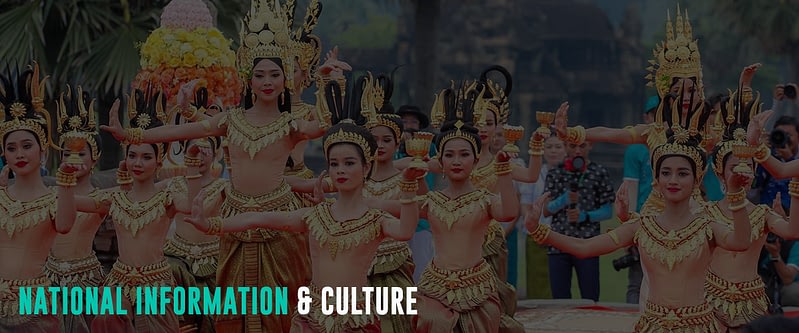
Cambodia, officially the Kingdom of Cambodia, is a Mainland Southeast Asian country. The country shares borders with Thailand to the northwest, Laos to the north, Vietnam to the east, and the Gulf of Thailand to the southwest. The capital and most populous city is Phnom Penh, and the official currency is Cambodian Riel (KHR).
Cambodia is a less-developed country with a long history of foreign occupation and war. The most unforgettable is the Khmer Rouge, which carried out the Cambodian Genocide from 1975 to 1979. In this period, over a million of the population suffered and died of starvation, forced disappearances, and extrajudicial killings. Victims were put into mass graves scattered nationwide. Hence, visitors should approach discussions about this period with sensitivity.
When visiting temples, showing respect by dressing modestly and refraining from inappropriate behavior is essential. Cambodia is a conservative country, and revealing clothing may be considered disrespectful.
The traditional greeting in Cambodia, known as the “sampeah,” involves placing both hands together in a prayer-like gesture and bowing slightly. It is a sign of respect commonly used when meeting someone older or of higher status. In Khmer culture, the head is considered the most sacred part of the body, and touching someone’s head, even playfully, is considered impolite.
Lastly, the region has a haggling culture. Do so respectfully and save some money. Travelers might never get the local price, but they might come close.
Visit the Cambodia Ministry of Tourism website for more information when planning your trip.
Special Travel Considerations

Each country and destination has rules and regulations that every traveler must consider. Hence, check the following considerations for hassle-free travel to Cambodia.
Covid-19 Protocol
As of July 11, 2022, the Cambodian government has relaxed its COVID-19 protocols. Fully vaccinated travelers do not need COVID-19 testing and quarantine upon presentation of vaccination certificates. Meanwhile, unvaccinated or not fully vaccinated visitors must undergo a COVID-19 Rapid Antigen test for a fee of $5 upon arrival in Cambodia. Check the latest update related to the coronavirus when planning your trip to Cambodia.
Travel Insurance
Effective 2022, travel and health insurance are not mandatory but highly recommended for visitors to Cambodia. Preferably, it must cover emergency medical treatment, including Covid-19, repatriation, and evacuation. Travel insurance can protect you against the inconvenience of injury, medical emergencies, theft, and flight cancellations. In addition, it is a comprehensive protection in case anything goes wrong with your trip.
Visa Information
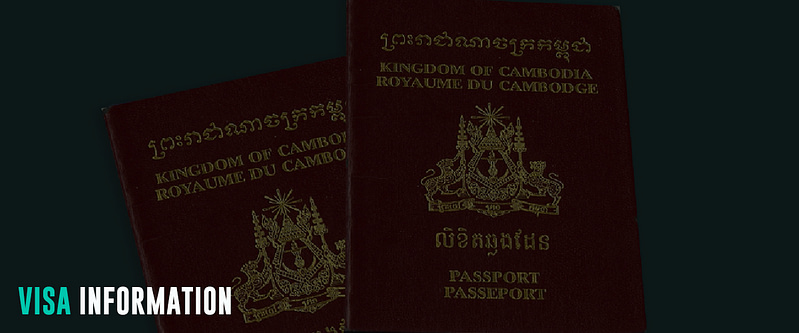
Regular passport holders from 10 countries, mostly ASEAN, do not need a visa to enter Cambodia and can stay 14 to 30 days. Meanwhile, other nationals must obtain a visa either before or upon arrival.
Visas to Cambodia are accessible upon arrival at Phnom Penh and Siem Reap International Airports and at land crossings from Thailand, Vietnam, and Laos. At these airports and borders, travelers may purchase a Cambodian visa valid for one month. They only need one recent passport-sized photo and at least six months of valid passport.
Tourists can also obtain visas in advance from the nearest Cambodian embassies or consulates. Certain nationalities, including those from Afghanistan, Algeria, Saudi Arabia, Bangladesh, Iran, Iraq, Pakistan, Sri Lanka, Sudan, and Nigeria, must obtain visas in advance from the Royal Embassy of the Kingdom of Cambodia in their respective countries.
Furthermore, visitors can opt for an online eVisa before traveling. The eVisa is subject to fees from $36 to $42, depending on the visa type. Also, consider the three (3) days of eVisa processing time.
Popular Attractions
Cambodia is famous for the magnificence of Angkor Wat and the horror of the Khmer Rouge period. It has a complex cultural tapestry and a long history. Moreover, Cambodia is also home to numerous stunning attractions, including beautiful and sunny beaches, lush natural wonders, ancient temples, and the charming capital city of Phnom Penh.
Angkor Wat
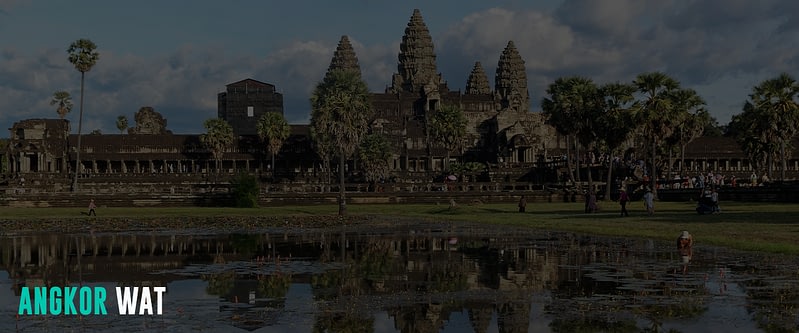
Angkor Wat is an expansive temple complex in Cambodia with over a thousand buildings. Spanning 162.6 hectares, it is the world’s most significant archaeological site and is recognized by the Guinness World Records as the most prominent religious structure globally. Angkor Wat’s majestic temples are a remarkable cultural wonder, a UNESCO World Heritage Site, and are a top destination for travelers.
Built in the first half of the 12th century by King Suryavarman II, Angkor Wat is an architectural masterpiece and the most significant monument of the Angkor group. Its construction took an estimated 30 years and is dedicated to Vishnu, representing a replica of the Angkor Thom style. The temple serves as the earthly representation of Mount Meru, a sacred mountain in Hinduism, and has been in continuous use, making it a source of national pride for Cambodia.
Angkor Wat’s profile boasts intricate carvings, symbolic motifs, and a quincunx arrangement of five towers. The temple’s plan is complex, with elevated towers, covered galleries, chambers, and courtyards on different levels linked by stairways. The architectural lines draw attention to the horizontal aspects of levels and the soaring height of the towers, creating an impressive lotus-bud profile.
Accessible from Siem Reap, Angkor Wat is Cambodia’s number one tourist spot. It is part of the larger Angkorian temple complex built between 802 and 1432, making it the largest city in the world during the medieval age. While the wooden dwellings have decayed, the remaining mighty temples, including Angkor Wat, showcase the architectural achievements of the Khmer kings. Other highlights in the complex include Ta Prohm, known for its tree-root-clasped temple, the Bayon Temple with 216 stone-carved faces, Angkor Thom, and Preah Khan. For a comprehensive exploration, three days are recommended, but even a shorter visit reveals the grandeur of this ancient site.
Bayon Temple
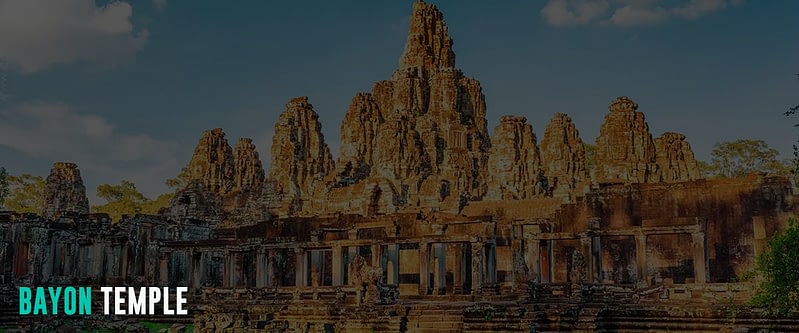
The Bayon, a Khmer temple, stands at the center of Angkor Thom. It served as the state temple of King Jayavarman VII during the late 12th or early 13th century. Distinctive for being the Angkor Empire’s sole Buddhist temple, Bayon features bas-reliefs depicting historical events, battles, and everyday life in Cambodia during the 12th and 13th centuries.
Recognized as the “Temple of Faces,” Bayon’s remarkable reliefs showcase over 200 Buddha faces on fifty towers, making it a prominent destination within the expansive Angkor complex. Originally named “Jayagiri” and later “Banyan Temple,” it eventually became “Bayon” due to a mispronunciation by local Khmer workers during restoration.
Despite looking like a pile of rubble from a distance, Bayon’s magic becomes apparent when explored. Its structure comprises three levels, each corresponding to distinct construction phases. The first two levels feature bas-reliefs depicting scenes of daily life, battles, and mythological tales, with the third circular level showcasing the iconic Buddha faces.
The upper level of Bayon boasts 54 Gothic towers adorned with 216 faces of Avalokiteshvara. The bas-reliefs on the lower levels depict vivid scenes of daily life, Hindu rituals, and historical events, offering a glimpse into 12th-century Cambodia. Though debated, the number of face towers, 37 of which remain today, may symbolize the provinces of the Khmer Empire.
Bayon is part of the “big three” sites, along with Angkor Wat and Ta Prohm, that visitors should explore. The serene faces carved into the temple are iconic and offer unique photo opportunities. The temple’s architecture, distinct from Angkor Wat, reveals intricate carvings and an absence of moats or surrounding walls, protected instead by the city of Angkor Thom. It is the last state temple in the Angkor complex, undergoing modifications under different rulers.
Royal Palace and Silver Pagoda
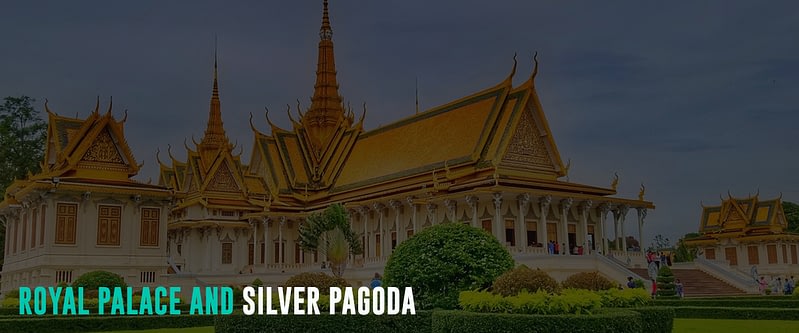
The Royal Palace in Phnom Penh, Cambodia, is a significant attraction, serving as the official residence of King Sihamoni. While some parts are closed to the public, visitors can explore the Throne Hall, surrounding buildings, and the adjacent Silver Pagoda. The Silver Pagoda, or Wat Preah Keo, stands out with its glittering silver floor and elegant design.
Initially constructed in 1892 and rebuilt in 1962, the pagoda houses extraordinary artifacts, intricate masks, and gold Buddhas. The Silver Pagoda also boasts a floor with 5 tons of gleaming silver tiles. The Italian marble staircase leads to opulent interiors featuring statues like the remarkable Emerald Buddha on a gilded pedestal. The Temple of the Emerald Buddha showcases lavish Buddha statues of precious metals.
Despite the Khmer Rouge’s preservation efforts during the Vietnamese invasion, more than half of the pagoda’s contents were lost. However, the remaining displays offer a glimpse into the brilliance and richness of Khmer civilization. Photography is illegal inside the Silver Pagoda. Still, visitors can explore the exquisite artisanship and historical artifacts, making it a must-visit destination within the Royal Palace compound.
Phnom Kulen National Park
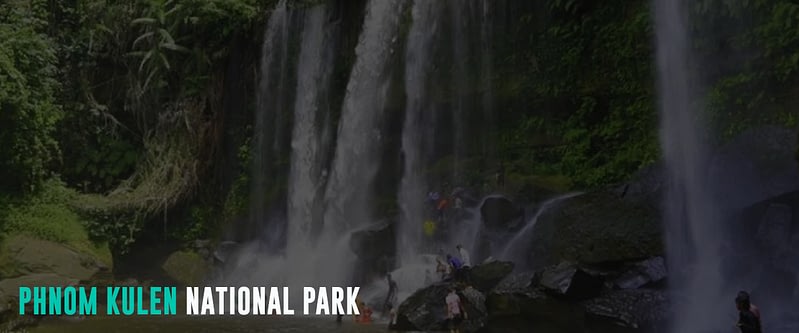
The Phnom Kulen National Park in the Phnom Kulen mountain massif in Siem Reap Province covers 373.76 km². It is famous for its lychee trees and is a popular attraction offering picturesque views, picnicking, and waterfall swimming. Visitors driving to the mountain top should arrive early due to one-way traffic on the road.
Known officially as Preah Cheyvaraman-Norodom Phnom Kulen National Park, it combines natural features with historical and cultural elements, making it a compelling destination. Two waterfalls within the park vary in size with the rainy season. The cultural and historical attractions, integrated into the natural setting, add to the park’s appeal.
Approximately 50 kilometers from Siem Reap, Phnom Kulen holds historical significance as the site where King Jayavarman II declared independence in 802 CE, marking the beginning of the Khmer Empire. It is also considered a sacred site with accessible temples.
Chup Preah Valley showcases statues from the 16th century, while Kbal Spean, or the “Valley of a Thousand Lingas,” displays carved figures along the riverbed. The Terrace of Sdach Kamlung reveals the remnants of a temple covered in lava. Other key highlights include Preah Ang Thom, featuring a tall reclining Buddha, and various religious and cultural statues. The park offers trails like the Kbal Speak Trail, a nearly 1-mile route along the riverbed and through the jungle, offering views of waterfalls and carved figurines.
Prasat Preah Vihear
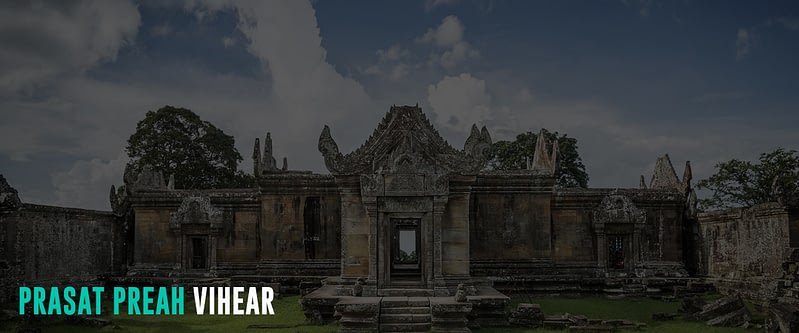
Perched atop the Dangrek Mountains on the border with Thailand, Prasat Preah Vihear is an 11th-century mountain temple. The temple complex dedicated to the Hindu deity Shiva is a UNESCO World Heritage Site renowned for its exceptional carved stonework.
Despite the temples of Angkor Wat gaining widespread recognition, Prasat Preah Vihear stands out for its dramatic location atop the Dangrek Mountains, offering breathtaking views of the Cambodian floodplains. The intricate stone ornamentation, staircases, pavements, and sanctuaries make it among Cambodia’s top tourist spots. Notable features include the stone-paved Nagaraj Courtyard, surrounded by snake heads and tails. Visitors can also explore nearby attractions like the Temple of Preah Vihear and Koh Ker.
The temple’s history is intertwined with border disputes between Cambodia and Thailand, with the International Court of Justice ruling in Cambodia’s favor in 2013. Tensions have eased in recent years, allowing Prasat Preah Vihear to regain its place on the tourist trail. Accessible from Sra Em, most visitors opt for a day trip from Siem Reap. However, accessing Prasat Preah Vihear involves a challenging journey, with a long and steep hike leading to the historic gates.
Koh Rong Samloem
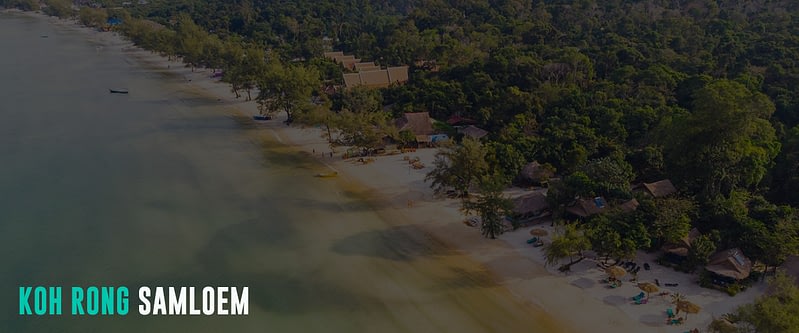
Koh Rong Samloem is one of Cambodia’s beautiful islands, offering a relaxing getaway after exploring Cambodia’s historical sites. Accessible from Sihanoukville, the ferry ride takes you to White Beach, setting the tone for relaxation.
Koh Rong Samloem provides a laid-back tropical experience and is a top choice for those seeking a perfect retreat. With its long sandy stretch, Saracen Bay features beach hut resorts, offering a tranquil escape. Activities include hammock time and scuba diving, contrasting the bustling mainland.
The island is famous for its beautiful beaches, including Koh Toch Beach, which attracts adventure enthusiasts. Activities such as snorkeling, diving, kayaking, and zip-lining are available. Police Beach, with a butterfly farm and mini zoo, showcases abundant wildlife. Other notable attractions on the island include Long Set Beach and Sok San Beach. Visitors can also experience the mesmerizing bio-luminescent plankton at Lonely Beach and Coconut Beach.
The island is home to spectacular wildlife, including monkeys and diverse bird species like the great hornbill, kingfisher, and osprey. The Jungle Trail walk may offer glimpses of monkeys, adding a touch of adventure to the serene island experience. Koh Rong is also home to a fantastic variety of marine species. Divers and snorkelers regularly emphasize the abundance of delicate miniature ecosystems, seahorses, and nudibranchs.
Choeung Ek Killing Fields
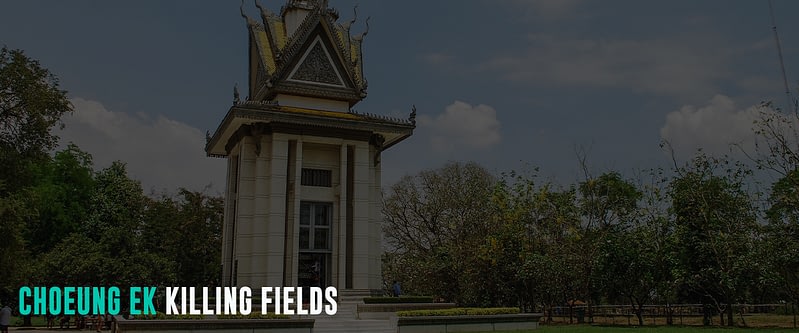
Choeung Ek, 17 kilometers south of Phnom Penh, serves as a haunting reminder of the atrocities committed during the Khmer Rouge regime from 1975 to 1979. The Killing Fields, as it is known, witnessed the extermination of around 20,000 individuals who were transported from S-21 prison. Today, it is a peaceful but poignant site with well-preserved mass graves and remnants of the tragic past.
The memorial includes an audio tour providing insights from survivors and accounts by former guards, like Him Huy, who chillingly describes the techniques used in the executions. The remains of 8985 victims, exhumed in 1980, are visible in the 129 communal graves, and over 8000 skulls are displayed in the Memorial Stupa.
While emotionally challenging, a visit to Choeung Ek is an essential part of understanding Cambodia’s modern history, particularly the Khmer Rouge’s violence under Pol Pot. The memorial, signposted in English, offers an educational experience complemented by an annual memorial ceremony on May 20th.
Travelers can hire a moto or take a shuttle bus tour Phnom Penh Hop On Hop Off to reach Choeung Ek. Combining this visit with the Toul Sleng Genocide Museum further deepens the understanding of Cambodia’s tragic recent past. Choeung Ek and Toul Sleng are just some of the killing fields and mass grave sites in Cambodia.
Phnom Penh
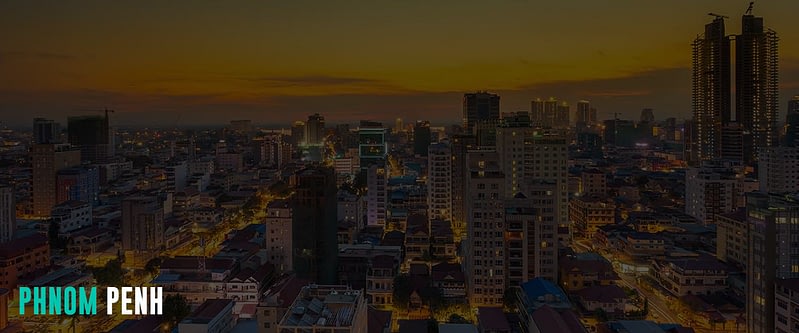
Phnom Penh, Cambodia’s bustling capital, positioned at the confluence of the Mekong and Tonlé Sap rivers, was historically significant for both the Khmer Empire and French colonialists. The city’s walkable riverfront hosts landmarks like the Royal Palace, Silver Pagoda, and the National Museum, showcasing artifacts from across Cambodia. At its center stands the massive Art Deco Central Market. While the National Museum showcases Khmer sculpture, tracing Cambodia’s history, the Royal Palace exhibits traditional artistry. The Tuol Sleng Museum and Choeung Ek’s killing fields reveal the dark chapter of Khmer Rouge rule.
As one of Cambodia’s largest cities, Phnom Penh is renowned for its vibrant streets, diverse dining options, and scenic riverfront with parks. Once known as the “pearl of Asia,” it boasts French-style architecture in the French Quarter, including the Cambodia Post Office and landmarks like the Russian Market for fashion and jewelry.
Despite being deserted during the Khmer Rouge era, Phnom Penh has revived into one of Southeast Asia’s dynamic cities. It remains Cambodia’s most cosmopolitan destination, featuring a lively café and restaurant scene unmatched in the country. The city preserves its charm as the leafy capital, adorned with palaces and wats. With its unique blend of French colonial houses and roadside pagodas, Phnom Penh is a top destination in Cambodia.
Siem Reap
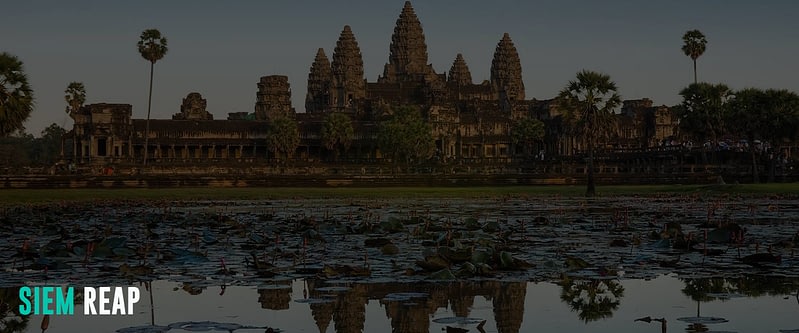
Siem Reap, Cambodia’s second-largest city and the capital of Siem Reap Province, is renowned as the unofficial tourism capital of Cambodia. As the gateway to the Angkor Archaeological Park, Siem Reap boasts numerous natural and architectural attractions, including breathtaking temples, colonial buildings, museums, cultural theme parks, lakes, and mountains.
Siem Reap offers more than just the temples. Pub Street, a vibrant nightlife hub, draws crowds worldwide and locals alike. The street, illuminated with bright neon lights, comes alive at night, featuring bars, restaurants, shops, and the Night Market. Siem Reap is more than just a stopover for Angkor; it also features silk farms, traditional craft shops, road tours through rice paddies, bird sanctuaries, fishing villages, and boat tours on Tonle Sap Lake. Wat Bo village houses the oldest Buddhist temple, and Apsara dance performances are must-visit attractions. Other key tourist attractions in Siem Reap include Bayon and Ta Prohm Temple, making it a captivating destination beyond the renowned Angkor temples.
For a deeper understanding of the Khmer Empire’s culture and artistry, visitors can explore the Angkor National Museum before heading to Angkor Wat. Evening entertainment options include the Phare The Cambodian Circus, known for dazzling shows combining theater, acrobatics, and music.
Primary Spoken Language(s)
The Cambodian language is Khmer, which has influences from the Thai and French languages. English and French are the popular second languages in Cambodia, with Chinese in third place.
Once the language of Indochina, French is still widely spoken by older Cambodians and is the medium of instruction in some schools and universities funded by the government of France. Notably, there has been a growing use of English in Cambodia. English is widely taught in several universities and is commonly used in hotels and business compounds nowadays.
Safety Concerns
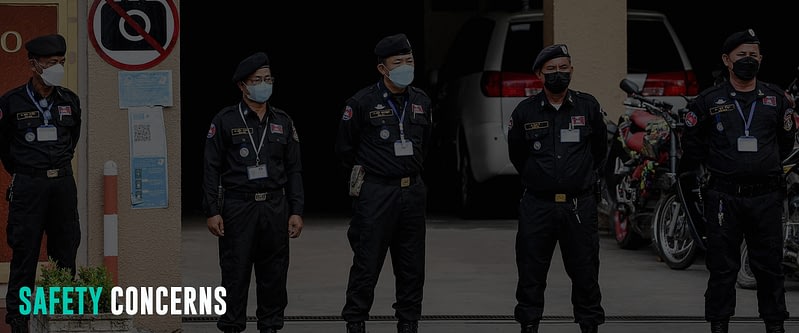
Cambodia is a safe country and destination for travelers, ranking 71st out of 161 countries on the 2023 Global Peace Index, and has a Level 1 Travel Advisory from the US Department of State. Hence, travelers in Cambodia can exercise standard precautions when exploring the country.
The crime rates are relatively low, but what concerns tourists is petty theft and bag snatching. Pickpockets, some posing as beggars, operate in markets and tourist sites. The most common type of theft is “snatch and grab” robbery, targeting easily accessible items like cameras, jewelry, purses, and backpacks. Hence, travelers must exercise caution, especially when using “tuk-tuks,” as passengers are often targets. To minimize the risk, keep belongings out of sight and carry items on the shoulder away from the street. Additionally, visitors must refrain from flaunting large sums of money or expensive gadgets and always be mindful of their belongings.
Not only that, but visitors to Cambodia must know of scams occurring. Beware at some border crossings overcharging the visa on arrival fees. Also, beware of fake police officers demanding to check passports. Please do not give in; tell them the passport is in a safety deposit box in the hotel. Chances are they will ask a “fine” to get it back.
Traveling on country or rural roads after dark is hazardous, so sticking to tourist areas and using a guide is advisable. Lastly, be careful in remote areas with landmines, particularly in Battambang, Banteay Meanchey, Pursat, Siem Reap, Kampong Thom, and Oddar Meanchey provinces. Without a local guide, travelers should not walk in forested or dry rice paddy areas. Avoid touching anything resembling a mine or unexploded ordnance and report such findings to the Cambodia Mine Action Center.
In an emergency, dial 119 for assistance.
Health Safety
Vietnam tends to be hot and humid, with temperatures rising from 30 °C to 40 °C in some places during April. Thus, sunburn, dehydration, and heat stroke can be of concern, especially in the central plains and Phnom Penh.
Mosquito-borne diseases such as dengue and malaria are becoming an issue in Cambodia. Dengue is widespread, while malaria is at risk in the mountain regions. Therefore, it is best to regularly use mosquito repellant and anti-malarial pills if you travel to remote Cambodian destinations.
Also, travelers to Cambodia can be vulnerable to waterborne and foodborne diseases such as diarrhea. Hence, drink only boiled or bottled water, eat freshly cooked foods, and avoid raw or undercooked foods.
Local Laws
Cambodia restricts freedom of speech, particularly concerning criticism or insults against the King. Individuals engaging in such actions, including online or via social media, may face imprisonment from one to five years. The government utilizes libel and slander laws to curb public discussion on sensitive topics or matters against its interests.
Drug offenses have severe consequences, including lengthy prison sentences, even for small amounts of illegal drugs. ‘Modesty’ laws are enforced at religious sites like Angkor Wat, requiring visitors to wear clothing covering their knees and shoulders.
Lastly, exercise caution when taking photos. Avoid photographing people, including monks, without permission. Also, avoid taking pictures near sensitive sites such as military areas, transport hubs, or government buildings. Photographing anything perceived as military or security interest, like government buildings, military installations, airfields, and bridges, may lead to issues with authorities, potentially resulting in confiscation of your camera.
Natural Disaster
Severe weather can happen in Cambodia, especially during the rainy season. Cambodia can be prone to typhoons from May to October and flooding during the monsoon season. In case of a natural disaster, always follow the instructions of local authorities.
Budget Considerations
Cambodia is one of the cheapest travel destinations in Southeast Asia and has become a favorite backpacking destination for nomads.
Accommodation
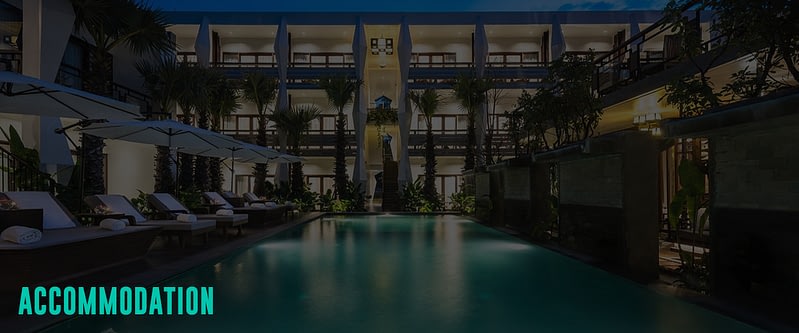
Cambodia has many affordable places to stay. Also, most accommodations offer complimentary WiFi, and some have outdoor swimming pools. However, complimentary breakfast and kitchen facilities are rare in Cambodian hostels.
Travelers can get a bed in a hostel dorm for as low as $5 per night and $15 for a private room. Moreover, visitors can stay in a three-star hotel for $25 per night and in luxury five-star hotels for $65. Another option for accommodation in Cambodia is Airbnb, where an entire home or apartment costs around $25 to $35.
Food
Cambodian cuisine has a French influence and is similar to Thailand and Vietnam. A Cambodian meal staple is rice, freshwater fish, and spices such as lemongrass, galangal, turmeric, tamarind, ginger, chili pepper, and lime. Popular dishes are the breakfast rice noodle dish num banh chok, amok trei (fish curry), catfish or pork, and roasted ground rice. Being a tropical country, Cambodia has many fruits, such as mango, mangosteen, passion fruit, dragon fruit, and durian.
Overall, food is very affordable in Cambodia, and travelers can get a meal from local street vendors for $1 to $3. Street foods and snacks cost even less! Dining in a basic restaurant costs $3 to $5 per meal for a typical dish like curry or fish and rice. Meanwhile, fast food and western meals are around $5 to $10. Travelers who want to splurge can get world-class food in Phnom Penh for about $10.
Expect to spend $20 to $25 weekly for groceries for travelers wanting to cook their meals. It can include basic staples like rice, fresh produce, and meat or fish. But because most hostels and hotels don’t have kitchens and the street foods are cheap, it is not advisable to cook meals while in Cambodia.
Attractions and Transportation
The cost of attractions and activities in Cambodia varies. While some parks are free, other attractions and destinations collect around $10 to $10 admission fees. For example, admission and hiking to Bokor National Park is complimentary, though hiring a private guide costs $40 daily. Meanwhile, entrance to Phnom Kulen National Park costs $20, and the famous Angkor Wat is $37 per day or $72 for a seven-day pass.
Public transportation in Cambodia costs as low as $0.40 for the Phnom Penh City Bus. Other popular transport modes in Cambodia are tuk-tuk and motos. Fares are typically less than $5 and vary according to distance.
Average Two-Week Cost
Backpackers in Cambodia can comfortably live with a $40 daily budget or $560 for two weeks. It covers the costs of a hostel dorm bed, dining in cheap sit-in restaurants, taking public transportation, and visiting limited attractions.
On the other hand, mid-range travelers spend $80 daily or $1120 for two weeks. The budget includes three-star hotel accommodations, dining in more excellent restaurants, riding a taxi, visiting Angkor Wat, and doing other paid activities.
Lastly, travelers can enjoy luxury in Cambodia from $160 daily to $2240 for two weeks. It includes staying in a five-star hotel, fine dining, car hire, taking domestic flights, and availing all the paid tours and activities they want. So, for them, the sky is the limit for travel.
Customs And Import Restrictions
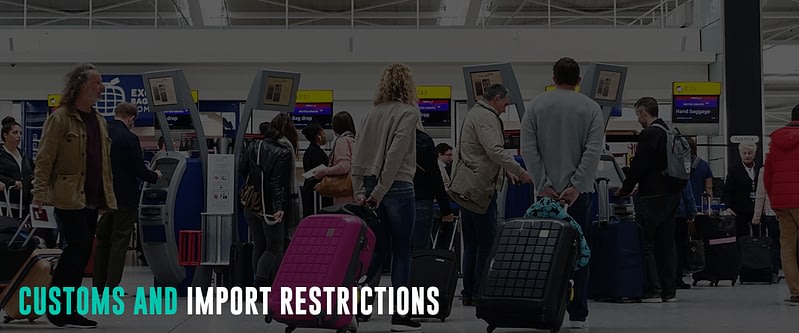
Travelers to Cambodia can bring goods and personal effects free from import duties and taxes. They may bring along goods not exceeding the following:
- 2 liters of any alcohol type
- 200 cigarettes, 50 cigars, or tobacco not exceeding 250 grams.
- 350 ml of perfume and cosmetics
- personal travel devices and gadgets
But note that alcohol and tobacco allowance exemptions do not apply to travelers under 18.
There are no restrictions on the number of currencies, gold, and precious stones or metals a visitor brings. However, travelers bringing over 300 grams of gold, 15 million Vietnam Dong, and other currencies over $5,000 must declare such items to Customs.
Customs law in Cambodia does not limit the import of foreign currencies. Travelers bringing the equivalent of 10,000 USD or more must only lodge a customs declaration at the border checkpoint. In addition, the export or import of raw gold, uncut precious stone, or raw precious metal equivalent to $10,000 or more shall require lodgment of a declaration at the National Bank and a customs declaration at the border checkpoint of Cambodia.
Furthermore, restrictions on some goods may require permits from pertinent authorities and an import or export permit from the General Department of Customs and Excise to enter Cambodia. These include the following:
- Weapons, explosives, ammunition, and other military equipment.
- Artifacts, statues, antiques, and ancient items.
- Plants and live animals.
Cambodian customs authorities prohibit the entry of firecrackers, electronic cigarettes, radioactive materials, flammable products, poison and toxic products, magnetic materials, and irritants. Lastly, it is illegal to bring narcotic drugs to Cambodia. Drug trafficking is a serious crime, and offenders will face prosecution. Visit the General Department of Customs and Excise portal for the complete list of customs policies and import restrictions in Cambodia.
Climate Considerations
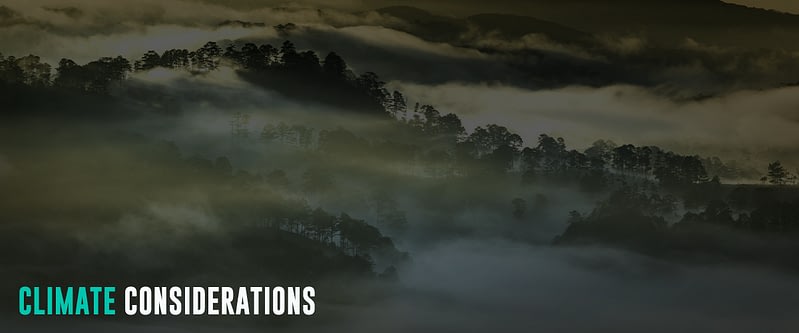
Cambodia is a tropical country just above the equator. Hence, the climate is generally tropical and influenced by monsoon, resulting in distinct wet and dry seasons. However, the dry season has two sub-seasons: cool and hot. The southwest monsoons bring moisture from May to October, constituting the rainy season. The dry season is marked by the northeast monsoon from November to April.
The rainy season from May to October is at 27-35 °C. During this season, temperatures drop, and high humidity prevails. Daily afternoon showers last less than an hour. Sometimes, umbrellas are ineffective due to powerful winds. Plastic ponchos and flip-flops are advisable. Despite the rain, this season is less crowded with tourists.
The dry season lasts from November to April. The weather cools from November to February, with temperatures ranging from 17-27 °C. The temperature increases from March to mid-May at 29-38 °C. April is the hottest month, reaching up to 40 °C. Despite being the dry season, humidity makes it feel hotter. The hot season is marked by oppressive heat and occasional short, powerful showers.
Primary Transportation Options
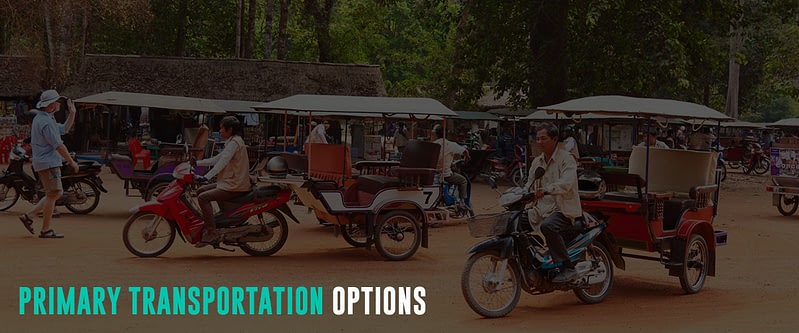
The transportation system in Cambodia is relatively underdeveloped, though improvements are on the way. But it does not stop travelers from exploring its natural beauty, as getting around can be part of the adventure. Nonetheless, various transport options are available to get around Cambodia.
Air
Cambodia has three significant airports operating international and domestic flights. The newly opened Siem Reap-Angkor International Airport is now the largest, while Phnom Penh International Airport is the busiest. Another major airport in Cambodia is Sihanouk International Airport. There is also an ongoing construction of a new and bigger airport in Phnom Penh. The Techo Takhmao International Airport is expected to be operational in 2025, attract more airlines, and improve connectivity in the country.
There are few domestic flights within Cambodia, primarily connecting the significant destinations of Phnom Penh, Sihanoukville, and Siem Reap. Flights between these cities are relatively expensive and have infrequent schedules. Cambodia Angkor Air is the country’s flag and airline carrier, with additional flights by smaller operators such as Aero Cambodia Airlines, Lanmei Airlines, Sky Angkor, and Bassaka Air.
While limited flights connect Siem Reap and Phnom Penh, as well as Siem Reap and Sihanoukville, most expats find private taxis or long-distance buses more cost-effective than the relatively expensive flight options. Fares for flights between Phnom Penh, Siem Reap, and Sihanoukville typically range from $60 to $80 one-way. Last-minute bookings can result in significantly higher prices.
Boat
Daily boat services operate between Phnom Penh and Siem Reap. There are also boat schedules between Siem Reap and Battambang, offering a scenic journey across the vast Tonle Sap Lake. While not the most efficient or cost-effective means of travel, boat trips can be picturesque and enjoyable. Boats also run south along the Mekong between Phnom Penh and the Vietnamese border at Chau Doc. Regular ferries and speedboats depart from Sihanoukville to Koh Rong and Koh Rong Samloem.
The 6-hour ferry ride from Siem Reap to Phnom Penh costs $18-25 and $25 between Siem Reap and Battambang. Another popular boat route is between Phnom Penh and Chau Doc. Daily departures are available by the Hang Chau Boat Company at $15 per ticket for the 4-5 hours voyage.
Eight boat companies, including Khemara Express Boat, Soon Ly Boat, and Royal Express Boat, provide Phnom Penh and Siem Reap services. Departure times are typically at 7:00 AM, and tickets are available for advance purchase or at the location. Boats have air-conditioning, toilets, and video TV, offering passengers a comfortable journey with rooftop views of spectacular scenery and authentic Cambodian villages.
Train
Cambodia’s train services are operated by Royal Railway. It primarily connects Phnom Penh to Battambang Province. The line between Phnom Penh and Sihanoukville, with stops at Takeo and Kampot, is also operational. Despite improvements, trains are not a standard mode of transportation in Cambodia due to the state of rail infrastructure and limited departures.
Trains run once a day from Phnom Penh to Sihanoukville on Friday, Saturday, and Sunday, with the whole route taking around 7 hours at a cost of approximately $7. Meanwhile, tickets from Phnom Penh to Battambang cost $8.
Car Rental
While car rental offers a flexible way to travel in Cambodia, it is challenging to hire one. Renting a self-drive car is virtually impossible, and if achieved, it comes with headaches such as documentation issues, haphazard driving by others, and inadequate insurance coverage, making the driver responsible for any loss or damage. Additionally, finding designated car parks is a real problem. Hence, hiring a car with a driver is a less troublesome and likely cheaper alternative.
A driver must possess a Cambodian driver’s license to drive in Cambodia, as International Driving Permits are not recognized. Two options are available for foreign drivers to obtain a Cambodian license: applying for a permit through examination, valid for ten years, or exchanging their current national driving permit for a Cambodian license, good for one year. Application must be done in person at the Department of Public Works and Transportation office, and an English translation of the existing permit is required.
The driver’s position is on the left side of the car, and the minimum age for obtaining a driving license is 18. Rental rates vary depending on the car type, starting at $40 for a vehicle and at least $5 for a motorbike.
Public Transport
Cambodia has cheap but limited options for public transportation. Phnom Penh is the only city with public transportation network options. But the adventure starts from here!
Bus
Bus transportation in Cambodia is a cost-effective and convenient way to travel between major cities and provinces connected to Phnom Penh. The well-established tourist bus system is the easiest and cheapest transportation, particularly along the popular backpacker trail connecting Phnom Penh, Siem Reap, and Sihanoukville. Travelers can travel from Phnom Penh to Sihanoukville with fares starting from $6. Meanwhile, the journey from Phnom Penh to Siem Reap is $10, while Siem Reap to Sihanoukville costs $17.
Key bus companies include Giant Ibis Transport and Mekong Express, offering affordable luxury services, comfort, safety, and internet access. Other popular options are Soriya Bus (168) and GST Express Bus. While buses depart from respective company offices, no centralized bus stations exist. Travelers can obtain information about schedules and fares from guesthouses and tour operators or by visiting individual bus company offices.
Phnom Penh City Bus
Phnom Penh has recently expanded its public bus system to eight lines, offering valuable services for locals and tourists. While buses may be slower due to the city’s crowded streets, they provide a more relaxed way to navigate the capital. The municipal public transit system, Phnom Penh City Bus, operates daily from 5:30 a.m. to 8:30 p.m., with 11 bus lines connecting various city areas.
The buses, equipped with amenities like air conditioning, television, and WiFi, facilitate intercity mobility, including routes from the airport to the city center. Ticket purchases for longer journeys can be made in advance at travel agencies or bus stations. For shorter trips within the city, passengers can take buses from authorized bus stations.
Public buses charge approximately $0.40 per ride for adult passengers regardless of distance. Certain groups, such as older citizens, children under one meter tall, persons with disability, students, monks, manufacturing employees, and teachers, enjoy a free ride upon providing proof of identity. Payments are made directly to the drivers, and passengers can use the Stops Near Me app for route information and color-coded lines. Travelers can also download the Android and iOS versions of the Phnom Penh City Bus for bus routes and timetables.
Minibus
Minibuses in Cambodia offer a viable alternative to buses, departing from local transport stops at comparable or slightly higher prices. They cover similar routes but may include destinations not served by buses, like Sen Monorom to Banlung. Despite being somewhat faster, minibusses are often crowded and uncomfortable, especially for taller travelers due to limited legroom. However, deluxe minibus services, such as Mekong Express on major intercity and international routes, provide a relatively high fare but ensure a more comfortable experience with guaranteed seating and less overcrowding.
Taxi
Taxis are a popular means of transportation for many tourists and foreigners, especially in Cambodian cities. However, taxis in Cambodia sometimes do not use meters or have broken meters. In this case, travelers need to negotiate the price. Reliable taxi companies are Global (the country’s first taxi company), Great Wall (blue), Choice (yellow)
Introducing ride-hailing mobile applications has enhanced taxi competitiveness and contributed to self-regulation. Grab has come to Cambodia, but local alternatives, such as PassApp Taxis, Exnet Taxi, and iTsumo, are better established and often less expensive. These taxi apps operating in Phnom Penh allow travelers to book a metered taxi, SUV, or tuk-tuk on mobile phones.
Taxis typically cost double to triple the local transportation rates. Fares are generally at $0.60 per kilometer. To ensure a fair price, it’s advisable to ask hotel or hostel staff for a price estimate, preventing any potential overcharging.
Tuktuk
Tuk-tuks are famous and affordable transportation in Cambodia, especially in towns and cities. Tuk-tuks are two-wheeled carriages pulled by a motorbike, accommodating up to four people. They are considered a breezy and safer option than motorbike taxis due to their slower speed, making them a preferred choice for tourists.
These vehicles are widely available in big cities, and it’s essential to negotiate the fare in advance, usually not exceeding $5, depending on the distance. Longer journeys may have slightly higher fares in cities like Phnom Penh and Siem Reap.
For short tours and trips outside towns, tuk-tuks are recommended. They are prevalent around the temples of Angkor, providing a secure and enjoyable mode of transportation.
Motos
Motorbike taxis, or motos, are an efficient mode of transportation for short to long distances in Cambodia. Riding on the back of a motor vehicle in traffic can be intense, and it’s common for Cambodians to accommodate multiple passengers. However, travelers should limit the number of passengers per bike for safety reasons. Moto drivers are usually found near transport stops, landmarks, and road junctions, actively seeking customers. Recent laws mandate passengers to wear helmets; if the driver doesn’t provide one, it’s recommended not to proceed. Moto drivers can manage baggage between their knees and the handlebars, ensuring balance in chaotic traffic. Despite being less comfortable, motos are often the only means of transportation for longer trips out of town.
Start Trip Planning
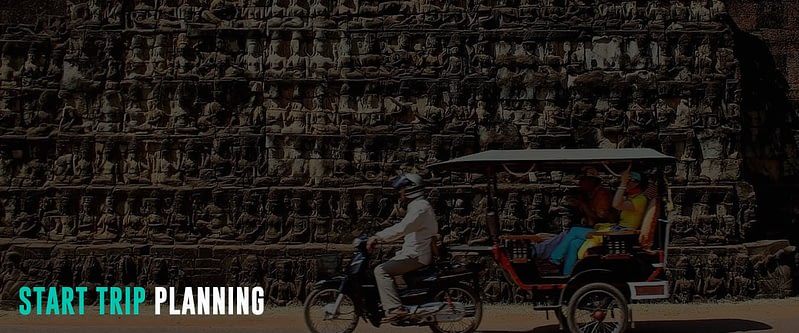
Travel-Wise is made from the ground up to help people travel more, break down the barriers that make it tough to get going, and start your journey as painlessly as possible. Bookmark our other Country Guides to help kick-start your research for future travels. We also offer templated itineraries from our staff and community that help serve as a building block for your trip plans. Alternatively, we also utilize AI to offer a way to generate itinerary ideas. This saves much time just getting you up and running with a template. From there, you can use the trip planner to create your customized itinerary, invite friends and family for collaboration, find others from Travel-Wise to join the trip, book and track important information, journal, and share your experiences at the end or along the way!

